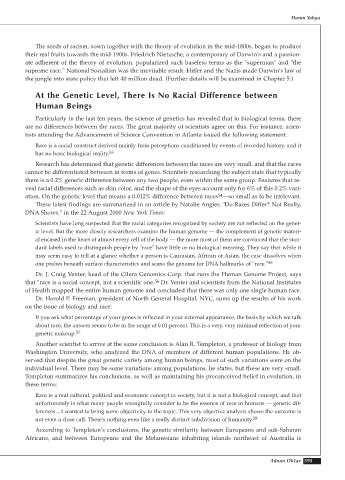Page 597 - Atlas of Creation Volume 3
P. 597
Harun Yahya
The seeds of racism, sown together with the theory of evolution in the mid-1800s, began to produce
their real fruits towards the mid-1900s. Friedrich Nietzsche, a contemporary of Darwin's and a passion-
ate adherent of the theory of evolution, popularized such baseless terms as the "superman" and "the
supreme race." National Socialism was the inevitable result. Hitler and the Nazis made Darwin's law of
the jungle into state policy that left 40 million dead. (Further details will be examined in Chapter 5.)
At the Genetic Level, There Is No Racial Difference between
Human Beings
Particularly in the last ten years, the science of genetics has revealed that in biological terms, there
are no differences between the races. The great majority of scientists agree on this. For instance, scien-
tists attending the Advancement of Science Convention in Atlanta issued the following statement:
Race is a social construct derived mainly from perceptions conditioned by events of recorded history, and it
has no basic biological reality. 53
Research has determined that genetic differences between the races are very small, and that the races
cannot be differentiated between in terms of genes. Scientists researching the subject state that typically
there is a 0.2% genetic difference between any two people, even within the same group. Features that re-
veal racial differences such as skin color, and the shape of the eyes account only for 6% of this 0.2% vari-
54
ation. On the genetic level that means a 0.012% difference between races —so small as to be irrelevant.
These latest findings are summarized in an article by Natalie Angier, "Do Races Differ? Not Really,
DNA Shows," in the 22 August 2000 New York Times:
Scientists have long suspected that the racial categories recognized by society are not reflected on the genet-
ic level. But the more closely researchers examine the human genome — the complement of genetic materi-
al encased in the heart of almost every cell of the body — the more most of them are convinced that the stan-
dard labels used to distinguish people by "race" have little or no biological meaning. They say that while it
may seem easy to tell at a glance whether a person is Caucasian, African or Asian, the ease dissolves when
one probes beneath surface characteristics and scans the genome for DNA hallmarks of "race." 55
Dr. J. Craig Venter, head of the Cilera Genomics Corp. that runs the Human Genome Project, says
that "race is a social concept, not a scientific one. 56 Dr. Venter and scientists from the National Institutes
of Health mapped the entire human genome and concluded that there was only one single human race.
Dr. Harold P. Freeman, president of North General Hospital, NYC, sums up the results of his work
on the issue of biology and race:
If you ask what percentage of your genes is reflected in your external appearance, the basis by which we talk
about race, the answer seems to be in the range of 0.01 percent. This is a very, very minimal reflection of your
genetic makeup. 57
Another scientist to arrive at the same conclusion is Alan R. Templeton, a professor of biology from
Washington University, who analyzed the DNA of members of different human populations. He ob-
served that despite the great genetic variety among human beings, most of such variations were on the
individual level. There may be some variations among populations, he states, but these are very small.
Templeton summarizes his conclusions, as well as maintaining his preconceived belief in evolution, in
these terms:
Race is a real cultural, political and economic concept in society, but it is not a biological concept, and that
unfortunately is what many people wrongfully consider to be the essence of race in humans — genetic dif-
ferences... I wanted to bring some objectivity to the topic. This very objective analysis shows the outcome is
not even a close call: There's nothing even like a really distinct subdivision of humanity. 58
According to Templeton's conclusions, the genetic similarity between Europeans and sub-Saharan
Africans, and between Europeans and the Melanesians inhabiting islands northeast of Australia is
Adnan Oktar 595

